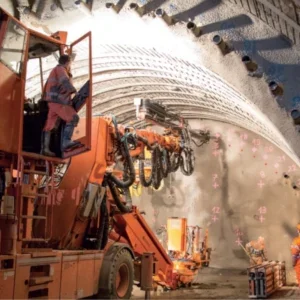In the hills of West Austin lies the completed Water Treatment Plant 4 (WTP4) project, which cost more than USD 500M to deliver. It is a project that has been in the pipeline since the 1970s, and although voters approved a bond that allowed the city to purchase a 240-acre site intended for WTP4 in 1984, the project still stirred controversy over environmental concerns and a debate over the budget. It was only in 2009 that the city council approved the project to build WTP4 and that construction began.
There are two separate contracts for the underground construction on WTP4 – the raw water system and the Jollyville Transmission Main (JTM). The raw water system mainly comprises an intake on Lake Travis, a raw water tunnel, a pump station and the treatment plant. While the JTM connects the plant to the existing water distribution system at the Jollyville Reservoir. The JTM tunnel was packaged separately to ensure it was completed around the same time as the other project components.
"Due to rapid population growth and the need for a safe and reliable water supply to meet area’s future needs the City of Austin embarked on USD 508M project to construct a new water treatment plant raw water intake and the Jollyville Transmission Main tunnel," says John Arciszewski, project manager for the JTM contract from Southland.
The area is also the epicentre of Central Texas’ ongoing drought. The two existing water treatment plants servicing the Austin metropolitan area draw water from impoundments of the Colorado River. The new WTP4 will take raw water from Lake Travis, a deeper water source at a higher elevation, providing a reliable system and continuous service during shutdowns and repairs for the other treatment plants with far less pumping costs. The new plant, which is located on Lake Travis, is capable of treating 50 million gallons a day (mgd) with room to expand to 300 mgd.
"This investment will add reliability by giving utility customers an additional plant that draws from Lake Travis instead of Lake Austin, save energy in serving the north and northwest Desired Development Zone, and provide for continuous service during shutdowns and repairs of Austin Water’s two other treatment plants and ageing pump stations, which are critical to getting water to customers.," he says.
In December 2014, the mayor of Austin, Lee Leffingwell, toasted the project at its opening ceremony. He commented: "The new facility is an important step forward for Austin. As we grow, it’s vital that we invest in infrastructure that will assure the security, sustainability, and reliability of our water resources."
At the WTP4 site today, while major construction works have completed across both contracts, the contractors are now onsite working to finish minor construction tasks address punch list items, restabilise and revegetate disturbed areas, address warranty items, perform touch up paining and project close-out documentation.
Completing the JTM Tunnel
Since the project had multiple components, including the raw water intake system, water treatment plant and the JTM tunnel, the City of Austin chose the construction management-at-risk (CMAR) method to keep all components in a single contract, making this the largest CMAR tunnelling job in Texas. MWH Constructors, the construction arm of MWH Global, provided overall construction CMAR services.
"A key element to the project’s success was having a highly competent field engineering and inspection team tied in with the construction manager at risk during all aspects of construction," says a City of Austin spokesman.
More than two million man hours were required to complete the entire project. However, Arciszewski says that a large proportion of the man hours were used on the JTM contract, which was engineered by Black & Veatch with construction by the Southland/Mole JV.
"The Jollyville Transmission Main project had a large portion of the two million man hours worked on the WTP4 project all without a lost time accident in large part due to the safety culture embraced by Southland/Mole JV and all of its employees," notes Arciszewski.
"There were three safety programmes on the project; the City of Austin’s, the CMAR’s and Southland / Mole’s own programme. Each programme added another layer and taken as a whole was more comprehensive then each individually. At the beginning of each shift, a ‘toolbox’ talk was held in conjunction with light stretching to prepare for the task at hand."
Once water has been treated it will be carried via a 7ft (2.1m) diameter transmission pipeline from WTP4 to the Jollyville Reservoir, located at US 183 and McNeil Drive. The transmission main is installed inside of an approximately 10ft (3m) diameter underground tunnel.
The JTM project was excavated using three TBMs, and Arciszewski says that this decision was vital to the project’s success. "One of the key elements of the project’s progress was the decision to use three TBMs to excavate the three separate reaches on the project.
By using a Southland built machine on the first reach we were able to have that portion of the tunnel complete while the Robbins machine was being manufactured. This also allowed the retrieval shaft to be much smaller and we opted to drill that shaft."
While under construction, the TBMs had daily advance rates of more than 200ft (61m). Reach No 1 is more than 4,450ft (1,356m) long to the first access shaft; Reach No. 2, directly below the Balcones Canyonlands Preserve, is more than 20,400ft (6,218m) long to the second access shaft; Reach No. 3 is nearly 9,700ft (2,957m) long to the Jolleyville Reservoir access shaft.
For the JTM tunnel, a key challenge was passing through a formation consisting mostly of hard limestone, and below the karst formations. The three TBMs were able to complete the drive smoothly. "The Robbins Main Beam used in Reach number 2, the longest of the three runs at 20,600ft [6,279m], performed well excavating the Glen Rose formation having an average UCS of 2000psi and low quartz content. All three drives were in the same formation and the three machines performed well excavating the limestone," says Arciszewski. "The Glen Rose formation was very uniform and had very low hydraulic conductivity which was of particular concern when mining downhill. The TBM that Robbins partially rebuilt and used on reach 3 negotiated a very tight radius to enter the retrieval shaft before the reach 2 machine finished its drive."
The JTM tunnel was also lowered an additional 50ft (15m) to further reduce potential environmental impact in the area’s fragile karst geology. However, Arciszewski notes that the "construction considerations of lowering the tunnel invert were known at bid time and the project was planned accordingly".
There was a minor delay due to the late delivery of the reach 2 TBM, which was scheduled to arrive in May 2012, but was received just over a month later. MWH monitored the progress toward launching this TBM and requested an updated schedule, however Arciszewski says that the affect on the project was minimal. "The reach 2 TBM was delivered approximately one month late and this delay carried through the excavation of the downgrade tunnel."
The raw water tunnel A couple of years ago, Tunnels & Tunnelling North America featured the raw water system contract and investigated the project’s progress. Aecom, with subcontractor Brierley Associates designed the raw water system while the contractors on the project included Manson Construction – for the raw water intake – and Obayashi USA, for the raw water access shaft, raw water tunnel and raw water transmission main tunnel.
At the time, the road header – one Antraquip AMQ 100 using pattern rock bolts for support for excavation – had been chosen by Obayashi to excavate both tunnels. The raw water tunnel was nearing completion while the access shaft and the transmission main tunnel expected to be flooding the raw water tunnel and the access shaft imminently.
"The construction of the Raw Water Tunnel, pump suction chamber and pump suction wells was completed in late summer 2013," says John Buser, senior project manager at Aecom. "Following this completion, the contractor opened valves on the bulkhead of the Raw Water Intake lake tap to allow water to enter the raw water tunnel. It required approximately three days to completely fill the raw water tunnel with water. After the raw water tunnel flooding was completed, underwater divers were used to enter the raw water intake and remove the bulkhead from the interior of the lake tap pipe. This was completed in October 2013."
The raw water pump station, located nearly a mile away from the raw water intake tunnel, was completed in late 2014.
"The raw water pump station construction began in March 2012, prior to completion of the Raw Water Tunnel," he adds. "The initial pump station construction consisted of the installation of underground pipe and electrical, followed by placement of the pump station foundation. The completion of the Raw Water Tunnel in October 2013 allowed the raw water pump station to proceed. The raw water pump station structure was completed adequately to install the pumps and pump installation began in August 2013."
Each pump shaft consisted of 34 sections, each section being 10ft (3m) long, that required precise connection before lowering into the pump suction well. It required approximately 15 days to install the pump base plate, shaft and discharge head for each pump. After installing all five pump assemblies, the 1500 Horsepower, 12,500 Volt motors were installed.
The pumps were tested in July 2014, with all five pumps operating as designed. The Raw Water Pump Station was placed into service in October 2014. The Water Treatment Plant began delivering drinking water to the City of Austin water distribution system in November 2014.
To date, the raw water pump station, the water treatment plant and the treated Water transmission main are operational.
All hands on deck
The City of Austin spokesman says that the project was completed on time and within budget. "Staying true to the value engineering and scope deferral process helped achieve the budgetary constraints of this project. Involving a dedicated environmental compliance manager to continually keep the contractor on point with addressing potential environmental issues, due to constructing the majority of the project in a karst/cave prevalent area surrounded by endangered species preserves, was key to keeping the construction moving in the field and minimising delays."
The spokesman adds that the transition from construction to operation has been smooth.
"Having owner’s operational staff on-site during start-up and testing, which ensured staff were familiar with the process and specifics of operations before taking operational responsibility of running the plant, has been a key element in the success of the project."
However, careful coordination between the large workforce was essential. "Coordinating and scheduling work to be completed and orchestrated together to facilitate startup and commissioning of the facilities required an ‘all hands on deck’ mentality," says the City of Austin spokesman.
"This involves the engineers, Austin Water Utility O&M staff, and CMAR’s construction and three startup/ commissioning staff to work together to fully vet all sequences leading up to the startup and operation of the massive project"






